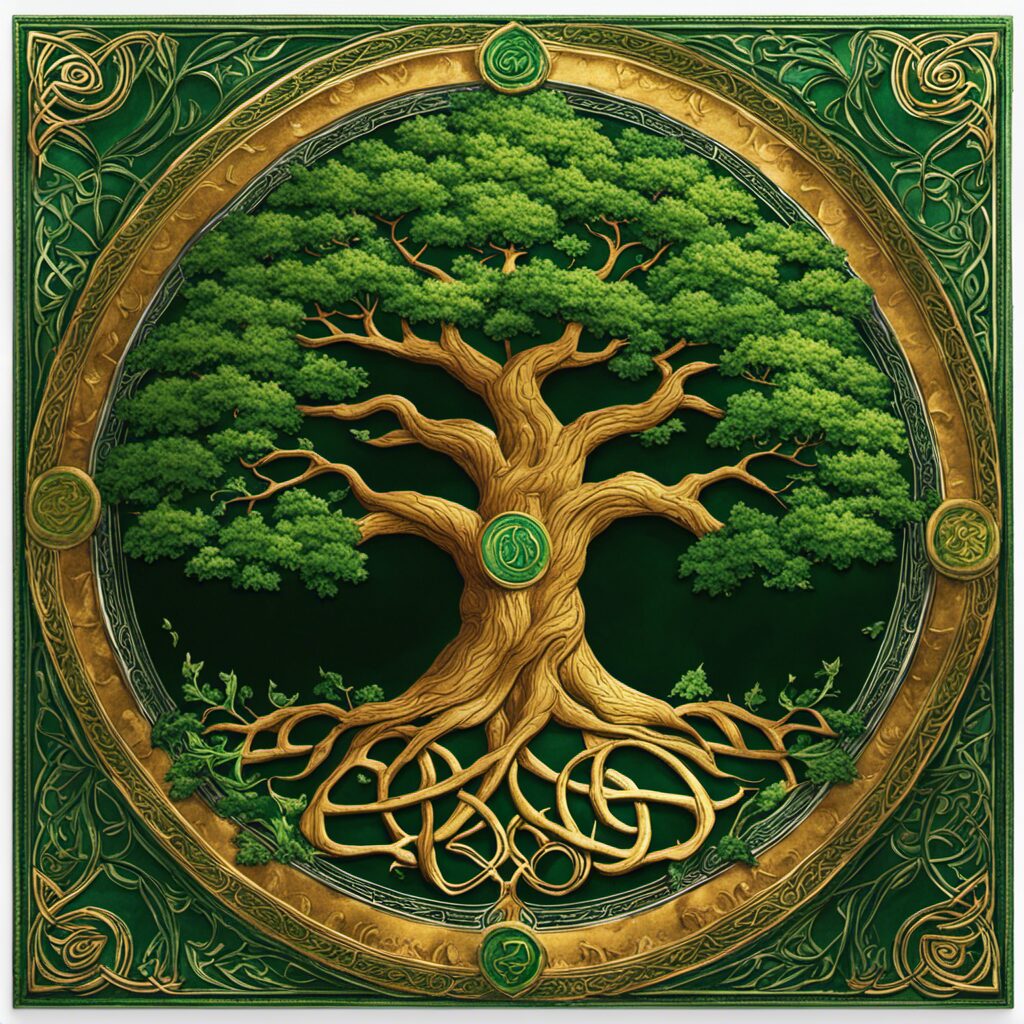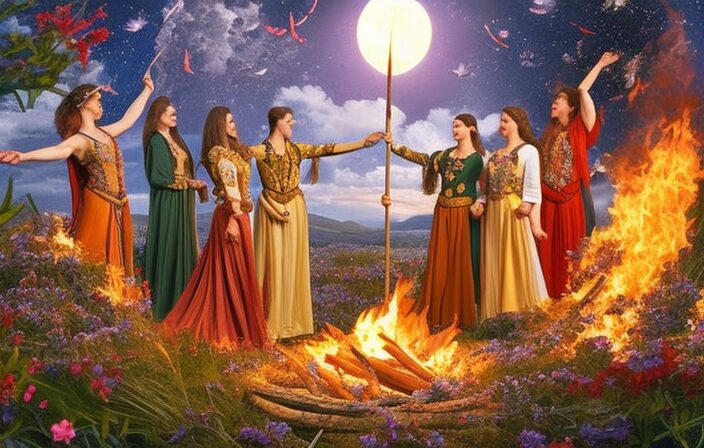The ancient Celtic culture is rich with a multitude of festivals and feasts, marking significant moments in their religious calendar. These traditional holy days hold great historical and cultural importance, providing insight into the beliefs and practices of the Celtic people.
With a deep-rooted connection to nature and the changing seasons, these celebrations serve as a way to honor deities, welcome new beginnings, and celebrate the cyclical nature of life.
In this article, we will explore the history and significance of Celtic calendar festivals and feasts, shedding light on their intricate rituals and symbolism.
Key Takeaways
- The Celtic calendar festivals and feasts are rooted in ancient Celtic cultures and follow a lunar-solar calendar system.
- Samhain, the Celtic New Year, is a significant festival marking the thinning of the veil between the physical and spiritual worlds. It is associated with Halloween and holds spiritual significance related to ancestors and transformation.
- Imbolc is a festival dedicated to the goddess Brigid, celebrated on February 1st. It involves rituals and traditions to honor Brigid’s presence and seek blessings, focusing on her associations with fertility, healing, poetry, and smithcraft.
- Beltane is a festival that welcomes the summer season and is celebrated by lighting bonfires, dancing around maypoles, and wearing flower crowns. It represents unity, fertility, and prosperity, and involves visiting sacred wells for purification and seeking blessings.
The History of Celtic Calendar Festivals and Feasts
The history of Celtic calendar festivals and feasts can be traced back to ancient Celtic cultures, where these holy days held significant religious and cultural importance. The Celts followed a lunar-solar calendar system, which determined the timing of their festivals and feasts based on the cycles of the moon and the sun. These celebrations marked important events in the agricultural year, such as planting, harvesting, and the changing of seasons.
One of the most well-known Celtic calendar festivals is Samhain, celebrated at the end of October or beginning of November. It marked the end of summer and was considered a time when the veil between this world and the Otherworld was thinnest. Bonfires were lit to ward off spirits and offerings were made for protection and guidance.
Another important festival was Beltane, celebrated around May 1st, which marked the beginning of summer. It was a time to honor fertility and growth with rituals involving bonfires, dancing around maypoles, and livestock being driven between two fires for purification.
Imbolc was another significant festival celebrated around February 1st to mark the beginning of spring. It celebrated purification, healing, and new beginnings with rituals focused on fire worship.
These ancient celebrations played an integral role in Celtic society by connecting individuals to nature’s cycles while also reinforcing community bonds through shared traditions.
Samhain – The Celtic New Year
Samhain, the Celtic New Year, holds significant spiritual importance in Celtic tradition. It is a time when the veil between the physical and spiritual worlds is believed to be at its thinnest, allowing for communication with ancestors and spirits.
Customs and rituals associated with Samhain include bonfires, divination practices, and feasting. Today, many of these customs have been adopted into modern Halloween celebrations, highlighting the enduring connection between ancient Celtic traditions and contemporary culture.
Samhain’s Spiritual Significance
In the context of traditional Celtic holy days, the spiritual significance of Samhain can be explored. This ancient festival marked the transition from harvest season to winter in Celtic culture and was believed to be a time when the veil between the living and spirit worlds was at its thinnest.
The spiritual symbolism associated with Samhain is rooted in ancient traditions that emphasized communing with ancestors and honoring the cycle of life and death. Some key aspects of Samhain’s spiritual significance include:
- Ancestors: Samhain provided an opportunity for individuals to connect with their deceased loved ones and seek guidance from ancestral spirits.
- Transformation: It symbolized a time of personal reflection, letting go of the old, and embracing new beginnings.
- Balance: Samhain highlighted the importance of maintaining balance between light and darkness, life and death.
- Nature’s Cycle: It acknowledged nature’s cyclical patterns, reminding people of their connection to the natural world.
Through these spiritual elements, Samhain served as a reminder of humanity’s place within the larger cosmic order.
Customs and Rituals
Customs and rituals associated with Samhain reflect the spiritual beliefs and practices of ancient Celtic communities. Celebrating traditions during this festival involved various symbolic practices that held significant meaning for the Celts.
One such practice was the lighting of bonfires, which symbolized purification and protection against evil spirits. These fires were also believed to aid in guiding the souls of the deceased to the Otherworld.
Additionally, costumes and masks were worn during Samhain festivities to disguise oneself from wandering spirits or to honor ancestral spirits.
It was customary for people to leave offerings of food, drink, and other items for their departed loved ones on altars or at gravesites as a way to show respect and maintain a connection with the spirit world.
These customs and rituals exemplify how Samhain served as a time for honoring ancestors and acknowledging the liminal space between life and death in Celtic culture.
Modern Halloween Connections
An examination of the evolution of Samhain customs reveals a strong connection between ancient Celtic practices and modern Halloween traditions. The celebration of Samhain, which marked the end of the harvest season and the beginning of winter in Celtic culture, has deep-rooted Celtic origins that have shaped Halloween as we know it today.
The cultural significance of this festival can be seen in various ways:
-
Costume wearing: In ancient times, Celts would dress up in animal skins and masks to ward off evil spirits during Samhain. This tradition is mirrored in modern Halloween celebrations where people don costumes to disguise themselves.
-
Bonfires: Lighting bonfires was an important part of Samhain festivities as it symbolized purification and protection against malevolent forces. Today, bonfires are still lit on Halloween night in some regions.
-
Divination rituals: Ancient Celts believed that during Samhain, the veil between the living and spirit worlds was thinnest, making it an opportune time for divination practices such as reading tea leaves or playing fortune-telling games. Similar divinatory activities are often associated with Halloween.
-
Trick-or-treating: While not directly linked to Samhain, trick-or-treating shares similarities with ‘souling,’ a medieval Christian practice where poor people would go door-to-door offering prayers for deceased loved ones in exchange for food. This tradition eventually merged with aspects of Halloween celebrations.
Imbolc – Celebrating the Goddess Brigid
Imbolc is a Celtic festival celebrated on February 1st, marking the halfway point between the winter solstice and the spring equinox.
The festival is dedicated to the goddess Brigid, who holds great significance in Irish mythology and religious traditions. Brigid is often associated with fertility, healing, poetry, and smithcraft, making her an important figure in Celtic culture.
During Imbolc, various rituals and traditions are observed to honor Brigid’s presence and seek her blessings for abundance and renewal in the coming spring season.
Brigid’s Significance in Imbolc
Brigid’s significance in the festival of Imbolc is widely recognized and celebrated in Celtic culture. As the goddess of hearth, home, and healing, Brigid plays a central role in this traditional Celtic holy day. Imbolc marks the beginning of spring and is associated with purification, fertility, and the return of light after winter.
Here are four key aspects highlighting Brigid’s importance in Imbolc traditions:
-
Brigid as a fire goddess: Lighting fires during Imbolc symbolizes Brigid’s transformative power and brings warmth to homes.
-
Sacred wells: People visit sacred wells dedicated to Brigid to seek her blessings for healing and protection.
-
Making Brigid’s crosses: Crafting these crosses from straw or rushes is believed to ward off evil spirits and bring good luck for the coming year.
-
Feast of St. Brigid: Imbolc also coincides with St. Brigid’s Day, which celebrates the Christian saint associated with many attributes of the goddess.
Through these practices, Brigid continues to be honored as a powerful deity during this significant Celtic festival.
Rituals and Traditions
Rituals and traditions associated with the festival of Imbolc reflect a deep reverence for nature and the changing seasons. Celebratory practices during this festival are rooted in ancient Celtic culture, highlighting the cultural significance of Imbolc within their society.
One such tradition is the lighting of bonfires, symbolizing purification and protection against evil spirits. These fires were often kindled on hilltops or in fields, serving as beacons to guide communities towards a prosperous spring season.
Additionally, individuals would visit sacred wells or springs to cleanse themselves and participate in rituals honoring Brigid, the goddess associated with fertility and healing. This act not only celebrated the renewal of life but also emphasized the connection between humans and nature.
These rituals and traditions reveal a profound respect for nature’s cycles and an acknowledgment of its vital role in sustaining life.
Beltane – Welcoming the Summer Season
The festival of Beltane, celebrated on May 1st, marks the beginning of the summer season in Celtic traditions. This ancient celebration is filled with welcoming traditions and joyful festivities to greet the arrival of warmer days and longer nights. Here are four key elements that make Beltane a vibrant and significant event in Celtic culture:
-
Bonfires: Beltane is characterized by the lighting of bonfires, which symbolize purification and renewal. These fires are believed to have protective powers, warding off evil spirits and ensuring a bountiful summer harvest.
-
Maypole Dancing: A central feature of Beltane celebrations involves dancing around a maypole adorned with colorful ribbons. The weaving patterns created by dancers as they move in opposite directions represent unity and fertility.
-
Flower Crowns: Participants often wear flower crowns during Beltane festivities. These garlands made from seasonal blooms serve as symbols of beauty, growth, and prosperity.
-
Sacred Wells: Visiting sacred wells during Beltane is another customary practice aimed at purifying oneself and seeking blessings for the coming year. People would often decorate these wells with flowers or offer small tokens as gifts.
Beltane continues to be celebrated today, both within Celtic communities and by those who appreciate its rich heritage. Its welcoming traditions and summer celebrations capture the essence of joyous anticipation for the warmth and abundance that lie ahead.
Lughnasadh – Honoring the Celtic God Lugh
Lughnasadh, celebrated on August 1st, is an ancient Celtic festival that honors the god Lugh. This celebration marks the beginning of the harvest season and is known for its significance in agrarian communities. Lugh, also known as Lugh Lamfada or Lugh Longarm, was a prominent deity in Celtic mythology associated with skills, craftsmanship, and agriculture.
The Lughnasadh celebration was an important event in Celtic culture and played a vital role in community cohesion. It involved various rituals and activities that highlighted the agricultural abundance and thanked the gods for their blessings. The festivities typically included communal feasting, athletic competitions such as horse races and spear throwing, storytelling, music, and dancing.
One of the key aspects of Lughnasadh was the symbolic sacrifice of grains or animals to ensure a bountiful harvest for the upcoming year. This act represented the cycle of life and death inherent in agricultural practices. Additionally, it was believed that by offering these sacrifices to Lugh, his power would be invoked to protect crops from diseases or pests.
Modern-day celebrations of Lughnasadh still exist among neo-pagan communities who seek to revive ancient Celtic traditions. These gatherings often involve reenactments of traditional rituals and ceremonies along with feasting on locally-grown produce. By honoring this ancient tradition, practitioners aim to reconnect with nature’s cycles and express gratitude for its abundant gifts.
The Winter Solstice – Yule and the Return of the Sun
The Winter Solstice, also known as Yule, marks the shortest day and longest night of the year in the Northern Hemisphere. This astronomical event has been celebrated and revered by various cultures throughout history. Yule traditions and winter solstice rituals are deeply rooted in ancient beliefs and practices associated with the cycles of nature and the return of the sun.
To provide a glimpse into this rich tradition, here are four key aspects of Yule celebrations:
-
Lighting of Yule Logs: The burning of a specially chosen log during the winter solstice symbolizes warmth, light, and hope for the coming year.
-
Decorating with Evergreens: Evergreen plants such as holly, ivy, mistletoe, and pine were adorned to represent life’s continuity even amidst darkness.
-
Feasting: Yule was traditionally a time for indulgence in hearty meals and festive gatherings celebrating abundance and survival through winter’s hardships.
-
Welcoming the Sun: Many rituals were performed to honor and encourage the return of longer days. These included sunrise ceremonies, lighting candles or bonfires at dawn, or even dancing around sacred fires.
These enduring Yule traditions serve as reminders that even in our modern world, we can find solace in reconnecting with nature’s cycles and embracing our shared human heritage.
Conclusion
In conclusion, the Celtic calendar festivals and feasts hold great significance in Celtic culture. These traditional holy days are deeply rooted in ancient traditions and beliefs, honoring gods and goddesses, welcoming seasons, and celebrating important milestones such as the New Year and the Winter Solstice.
The rich history behind these rituals provides a glimpse into the spiritual practices of the Celts. By exploring these festivals, we gain a deeper understanding of their cultural heritage and appreciate the importance of connecting with nature and divine forces.
What better way to celebrate our own traditions than by embracing the wisdom of our ancestors?




